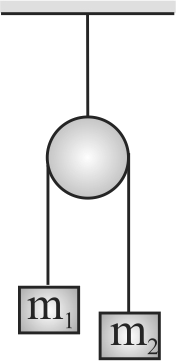365711
Two masses \({m_1} = 1\;kg\) and \({m_2} = 2\;kg\) are connected by a light inextensible string and suspended by means of a weightless pulley as shown in the figure. Assuming that both the masses start from rest, the distance travelled by the centre of mass in two seconds is (Take \(\left. {g = 10\,m{s^{ - 2}}} \right)\)
365712 Two particles of equal masses have velocity \(\overrightarrow {{v_1}} = 2\hat i\;m/s\) and \(\overrightarrow {{v_1}} = 2\hat i\;m/s\). The first particle has an acceleration \(\overrightarrow {{a_1}} = (3\hat i + 3\hat j)m/{s^2}\) while the acceleration of the other particle is zero. The centre of mass of the two particles moves in a:
365713 The velocity of the \(CM\) of a system changes from \(\overrightarrow {{v_1}} = 4\hat i\;\,m/s\) to \(\overrightarrow {{v_2}} = 3\hat j\;\,m/s\) during time \(\Delta t=2 s\). If the mass of the system is \(m = 10\;kg\), the constant force acting on the system is:
365711
Two masses \({m_1} = 1\;kg\) and \({m_2} = 2\;kg\) are connected by a light inextensible string and suspended by means of a weightless pulley as shown in the figure. Assuming that both the masses start from rest, the distance travelled by the centre of mass in two seconds is (Take \(\left. {g = 10\,m{s^{ - 2}}} \right)\)
365712 Two particles of equal masses have velocity \(\overrightarrow {{v_1}} = 2\hat i\;m/s\) and \(\overrightarrow {{v_1}} = 2\hat i\;m/s\). The first particle has an acceleration \(\overrightarrow {{a_1}} = (3\hat i + 3\hat j)m/{s^2}\) while the acceleration of the other particle is zero. The centre of mass of the two particles moves in a:
365713 The velocity of the \(CM\) of a system changes from \(\overrightarrow {{v_1}} = 4\hat i\;\,m/s\) to \(\overrightarrow {{v_2}} = 3\hat j\;\,m/s\) during time \(\Delta t=2 s\). If the mass of the system is \(m = 10\;kg\), the constant force acting on the system is:
365711
Two masses \({m_1} = 1\;kg\) and \({m_2} = 2\;kg\) are connected by a light inextensible string and suspended by means of a weightless pulley as shown in the figure. Assuming that both the masses start from rest, the distance travelled by the centre of mass in two seconds is (Take \(\left. {g = 10\,m{s^{ - 2}}} \right)\)
365712 Two particles of equal masses have velocity \(\overrightarrow {{v_1}} = 2\hat i\;m/s\) and \(\overrightarrow {{v_1}} = 2\hat i\;m/s\). The first particle has an acceleration \(\overrightarrow {{a_1}} = (3\hat i + 3\hat j)m/{s^2}\) while the acceleration of the other particle is zero. The centre of mass of the two particles moves in a:
365713 The velocity of the \(CM\) of a system changes from \(\overrightarrow {{v_1}} = 4\hat i\;\,m/s\) to \(\overrightarrow {{v_2}} = 3\hat j\;\,m/s\) during time \(\Delta t=2 s\). If the mass of the system is \(m = 10\;kg\), the constant force acting on the system is:
365711
Two masses \({m_1} = 1\;kg\) and \({m_2} = 2\;kg\) are connected by a light inextensible string and suspended by means of a weightless pulley as shown in the figure. Assuming that both the masses start from rest, the distance travelled by the centre of mass in two seconds is (Take \(\left. {g = 10\,m{s^{ - 2}}} \right)\)
365712 Two particles of equal masses have velocity \(\overrightarrow {{v_1}} = 2\hat i\;m/s\) and \(\overrightarrow {{v_1}} = 2\hat i\;m/s\). The first particle has an acceleration \(\overrightarrow {{a_1}} = (3\hat i + 3\hat j)m/{s^2}\) while the acceleration of the other particle is zero. The centre of mass of the two particles moves in a:
365713 The velocity of the \(CM\) of a system changes from \(\overrightarrow {{v_1}} = 4\hat i\;\,m/s\) to \(\overrightarrow {{v_2}} = 3\hat j\;\,m/s\) during time \(\Delta t=2 s\). If the mass of the system is \(m = 10\;kg\), the constant force acting on the system is: